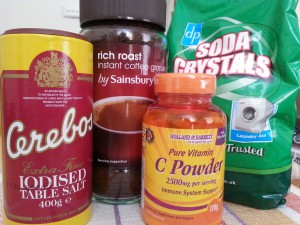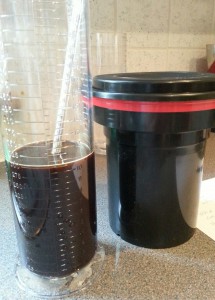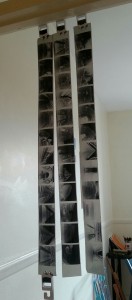Caffenol Without Vitamin C
Over the past year or two I've done a bunch of experiments with the Chemigram process and even combined it with the Lumen process. In the work so far I've used various different substances as resists to control the action of the developer and fixer on the paper, thus influencing the pattern of the light & dark regions. Meanwhile for film processing at home I have been using my Caffenol-C-H-UK recipe almost exclusively as the developer. Caffenol is not just for film, it can be used for developing paper too and it occurred to me one day that instead of mixing up the caffenol in a jug, it might be interesting to just let the caffenol ingredients mix and react directly on the paper. So began a new series of chemigram experiments without using any kind of resist at all.
Caffenol is made by mixing washing soda crystals, vitamin C, instant coffee and optionally some iodized salt. The coffee and vitamin-C are the developing agents while the washing soda acts as an accelerator. The first step was to make a solution of washing soda and water and thoroughly soak the sheets of paper in it. The granules of instant coffee can be placed individually on the paper where needed, or simply sprinkled in an adhoc manner. The vitamin-C powder can just be poured or sprinkled onto the paper. The theory is that when the coffee/vitamin-c hits the wet paper it reacts with the washing soda to form caffenol on the surface. This is done in normal lighting conditions so the paper is universally and totally exposed and should gradually turn black where the caffenol has formed.
For this first test I used off-cuts of some outdated ~|40 year old) Ilford FB paper approx 5×4 inches in size. It was soaked in warmed (~25 C) washing soda solution then some coffee was sprinkled on, followed by some vitamin-C powder. After a minute or so it is possible to see hints of development along the edges where the paper is going dark gray
After 5 minutes the developed areas didn't appear to be getting any darker. I figured that since the paper was quite lightweight and moderately glossy, it was probably not able to absorb very much of the washing soda solution thus limiting how much caffenol can form. The washing soda is critical as an accelerator, without it coffee/vitamin-C are far too slow. So to try and intensify things I used a syringe to squirt on some more washing soda, which made the vitamin-C fizz very nicely. This image shows the run-off is developing the paper quite efficiently after just a minute or so:
The surprise came when I decided to wash off the ingredients. It turned out that the instant coffee had formed quite a sticky sludge which had adhered well to the paper. Given the limited water holding capacity of the paper, the areas with great concentrations of coffee granules had ironically developed the least. There is just a slight gray speckling effect where the coffee had a very limited action on the silver halides. The areas of most intense development were along the edges where the coffee and vitamin-C had mixed initially, and then in the broad areas of run-off which had well mixed caffenol
The process was repeated, but without pouring washing soda over the ingredients, just relying in that initially absorbed by the paper. The results were fairly similar to the first test, but with less development of the surrounding paper, as would be expected due to lack of run-off.
The results obtained were partially aligned with the initial expectations of the process but, as always when experimenting, there were surprises. In particular the inability of the paper to absorb sufficient washing soda solution was a key limiting factor in the results. It was surprising to see how the coffee + vitamin-C alone were fairly weak, but when they combined they became stronger than the sum of the parts. Finally the way the coffee became a sticky mass on the surface of the paper actually caused it to act as a chemigram resist, as well as a developer at the same time!
With the initial experiments successfully completed it was time to try some larger scale work with full sheets of 8×10 paper. The goal was really to just do more of the same but on a larger scale. The first work was fairly light on washing soda, thus forming broadly static patterns showing the texture of the vitamin-c powder and coffee granules, though there were some limited areas of runoff creating dynamic swirling patterns
With the second print the aim to was make a very dynamic image showing the motion of developing liquid on the surface of the paper, at the expense of any fine detail.
Pleased with the results of caffenol in a pure chemigram process, I decided to take it a step further and try to combine chemigram with a traditional B&W development process in the darkroom.
A while ago I took an simple photo of the Moon with a DSLR and teleconvertors which I then used to create a digital negative on acetate for printing as a cyanotype. Astrophotography is an increasingly popular endeavour for many people, but almost without exception the aim is to produce images with the best sharpness and finest detail the equipment will allow. An unfortunate result is that any two images of the moon will look broadly alike, and my own astrophotography images of the moon are no exception. So I decided that this digitally captured moon image would provide a good challenge as source material for creating a truly unique photographic print.
In the darkroom under safe light conditions, I placed a sheet of outdated Ilford FB 8×10 paper under the enlarger. The digital negative went on top of the paper for purpose of contact printing. From previous experience contact printing on this paper I just guesstimated the exposure at 15 seconds, with lens at f/8. The paper now has an invisible latent image ready to be worked on by the caffenol.
I soaked the paper in a washing soda solution, randomly sprinkled instant coffee and vitamin-C onto the paper and then just let it sit for a few minutes to give time for the caffenol to start working. Part way through I also added a very small amount more washing soda in some areas to encourage the development. After approximately 3-4 minutes (I wasn't really timing this) I could see slight hints of the paper starting to turn gray in places. Washing off the caffenol residue though showed almost no development across most of the paper, which was initially disappointing.
None the less I now put the print through a regular B&W dev, stop & fix process. Rather than leaving it in the developer for the full 1 minute though, I noticed it was developing quite fast and choose to just move it to the stop bath when it "looked about right" – about 35 seconds. What was happening was that although not really visible yet, the caffenol had indeed kickstarted the development across the paper and the normal developer was just needing to finish off the process. If I had let the image site in the developer for the full 1 minute it would have been over developed and lost some of the qualities of the caffenol granulation.
The result was thus incredibly pleasing image of the moon, which I hereafter title "Moon through a dirty window"
Looking at the results obtained shows that the idea of using caffenol in a chemigram process has great possibilities for image making. On its own it can be semi-controlled to create attractive abstract images, while when combined with a regular B&W printing process it turn an otherwise plain image into an intriguingly textured pleasing artwork. I'm very much looking forward to getting back in the darkroom to further work through the possibilities this offers
Peak Imaging is my film processing lab of choice, since they have provided consistently good results and have very fast turn around times. Even if I can send the film off and get it back within 3 days though, that is still 3 days longer than it takes me to see digital photographs. A number of friends develop their own B&W film at home, since you don't actually need a proper dark room – a small changing bag suffices to transfer the films into the light proof processing tank. I've thought about doing this before, but the idea of dealing with lots of chemicals was never too appealing. While researching B&W film processing recently, I happened across an article on a website (I forget which exactly) mentioning that it is possible to develop film using home-brewed developer based on little more than instant coffee. The moment I read about this, I knew I had to try it out for myself.
The science bit
After a little more reading, I've learnt that Caffenol developers have 3 key ingredients, each serving a specific purpose.
- Instant coffee. This contains a variety of chemicals including caffeine, but the one that is thought relevant to film development is caffeic acid. This is a phenol which acts as the first developing agent reducing the silver halide to metallic silver, revealing an image on the film base.
- Washing soda. Photographic developing agents require an alkaline solution to activate them, but coffee is fairly acidic. Washing soda, aka sodium carbonate, acts as the accelerator raising the PH to a suitable level for the developing agent to operate.
- Vitamin-C. Caffeic acid on its own will result in very long development times, so the Caffenol-C recipes add ascorbic acid (aka vitamin-C) as a second developing agent to further speed up the reactions.
Reinhold's basic recipe for these 3 ingredients, Caffenol-C-M, is only suitable for use with film rated at 100 ISO (or lower). It is said to cause fogging of high ISO films during development. I primarily shoot Tri-X 400 in my ZeroImage 2000 pinhole camera, so the slightly more advanced, Caffenol-C-H recipe, was the one to go for – the 'H' stands for "High Speed". This adds a fourth ingredient, Potassium Bromide, which acts as a restrainer to prevent fogging. The minor irritation is that the latter isn't a common household ingredient. Fortunately Reinhold has since found that Iodized salt can be used in place of Potassium Bromide, and this is fairly easily found in supermarkets.
Getting started
I hadn't done any film processing at home before, so the first step was to obtain the minimal set of equipment. The Patterson film processing kit is a cost effective way to obtain the core pieces, vs buying them all separately, though searching for second hand items on eBay could probably cut cost even more. In addition, I got the cheapest digital scales that Silverprint stocked and a concertina storage bottle for storing fixer between use.
The recipes linked above need a little tweaking based on the precise ingredients used. In particular washing soda comes in a variety of formulations, anhydrous, monohydrate & decahydrate. Most of the recipes published on the web assume use of the andhyrous (waterfree) formulation, but it is possible to figure out the amount by which to adjust the quantities, by heating in an oven and measuring the weightloss. In the UK the most easily available washing soda is Dri-Pak Soda Crystals, for which people have already verified an adjustment value of x2.7. There isn't any available data on the amount of caffeic acid in the instant coffees you can get in supermarkets, but fortunately this doesn't seem to matter much – people have got acceptable results with almost any instant coffee. So don't waste money on the most expensive brands – pick any old cheap bottle of instant coffee. Pure Vitamin-C powder is available in most pharmacies in the UK, but at stupidly expensive prices. Holland & Barrett have tubs at slightly more reasonable prices, particularly when they have 2-for-1 special offers available. For the final ingredient, iodized salt, the only brand commonly available in UK is Cerebos Extra Fine Iodised Table Salt.

Caffenol-C-H ingredients
Caffenol-C-H-UK Recipe
With all that in mind, the following is a specific recipe derived from Reinhold's Caffenol-C-H using ingredients available in the UK to make 1 litre of solution. I'm calling this Caffenol-C-H-UK.
- 150g Dri-Pak Soda Crystals. Cost: £1.00 for 1kg
- 16g Holland and Barrett Vitamin-C powder. Cost: £6.99 for 170g
- 40g Sainsbury's Rich Roast Instant Coffee. Cost: £2.00 for 200g
- 12g Cerebos Iodized Table Salt. Cost: £0.75 for 400g
- water to make 1000ml of solution. Cost: free(-ish)
For a single 35mm film only 300ml of solution is required, so the quantities are
- 45g soda crystals. Cost: £0.045
- 4.8g vitamin C. Cost: £0.20
- 12g coffee. Cost: £0.12
- 3.6g salt. Cost: £0.006
- water to make 300ml of solution
- Cost: £0.37 per roll.
while for a single 120mm (medium format) roll film, 600ml of solution is required
- 90g soda crystals. Cost: £0.09
- 9.6g vitamin C. Cost: £0.40
- 24g coffee. Cost: £0.24
- 7.2g salt. Cost: £0.01
- water to make 600ml of solution
- Cost: £0.74 per roll
Compared to mail order film processing at about £4-5 per roll of film, or high street processing of as much as £10, Caffenol is very cheap. If you can get cheaper sources of Vitamin-C powder, then the cost will be drop even further. Of course this assumes your time is free too.
Mixing the developer
The critical thing to bear in mind when mixing up caffenol developer is that you are not making soup, rather you are attempting to perform a specific set of chemical reactions. For this reason, it is not advisable to simply mix all the ingredients in one go, instead follow a precise order of mixing.
- Fill the measuring cylinder with half the target volume of water from the cold tap. ie if the end goal is 600ml of solution, then fill with 300ml of water
- Pour in the soda crystals and stir for a couple of minutes until they are well dissolved. Since Dri-Pak soda crystals are a decahydrate, the temperature of the water will typically drop 8-10 degrees and the volume of solution will increase. NB anhydrous soda crystals would have instead raised the temperature.
- Pour in the vitamin C and stir, at the very least until it has stopped fizzing.
- Pour in the instant coffee granules and stir for about a minute. The solution will now be a disgusting looking brown sludge :-)
- Pour in the the Iodized salt and stir some more.
- Top up with further tap water to achieve the final desired volume of solution. The developer is intended to work at 20 C, and mixing in the soda crystals will have lowered it to about 10 C. So when topping up to the final volume, add hot water at first until it is 20 C, then finish topping up with cold tap water.
After everything is thoroughly mixed, allow the developer to stand for 5 minutes to ensure all the desired chemical reactions have completed. If you could not get the temperature to exactly 20 C during the mixing phase, then sit the cylinder in a basin of hot or chilled water as necessary to adjust to 20 C, stirring all the time.

Caffenol mixture
Processing the film
From this point onwards, fairly standard dark room film processing rules apply. Pour the Caffenol into the film tank, turn the stirrer several times and then seal the lid. Invert the tank 3 times and then bang it on the work surface to dislodge any bubbles. The quoted development time from Reinhold's site is 15 minutes, but for the images produced with my pinhole camera on Tri-X I find 13 minutes gives a better result. I suggest going for 15 minutes at first, and if the result is too high contrast (indicating over development) try reducing it a couple of minutes next time around. During the development time, invert the tank 3 times at the start of each minute.
Caffenol does not require a chemical stop liquid, so when the development time is up, invert the film tank pouring the caffenol down the sink, then rinse multiple times with cold tap water. Keep rinsing until the water is no longer brown, as this minimizes subsequent staining of the fix. Once rinsed, add any regular fix and follow the normal process for that. Since my kitchen has no air extractor fan, I use Fotospeed odourless fix to minimize the fumes. Despite multiple rinses, the fixer will probably still end up stained light brown, but this does not appear to affect its ability to work in any way, so don't discard it.
Once fixed, a thorough wash is needed. For this fill the tank with water, replace the lid and invert 5 times. Replace the water and then invert it 10 times. Replace the water once more and invert it 20 times. All that remains is to take 600ml of water, add a drop of Kodak PhotoFlo and dip the film squeegee into it. Then pour the water into the film tank, turn with the stirrer stick and invert it once to ensure the film is well coated. Now take the film off the reel, squeegee the water off it and hang it up to dry.

Film drying
For some example images processing with Caffenol, browse images on my new portfolio website
Source: https://fstop138.berrange.com/tags/caffenol/

0 komentar:
Posting Komentar